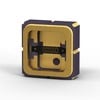LED Lamps
(772 companies)
LED lamps are light emitting diode arrays with traditional lamp ballasts.
Incandescent Lamps
(320 companies)
Incandescent lamps generate light by passing an electric current through a thin filament wire (usually of tungsten) until the wire is extremely hot.
Projection Lamps
(49 companies)
Projection lamps use a built-in reflector to concentrate light in a particular direction. They are used in applications such as slide projection, microfilm, overhead projection, movies, medical / scientific instruments, airport runways, and others.
Stage Lamps
(52 companies)
Stage lamps are used for stage, studio, or television lighting. They are often made of quartz instead of glass to provide higher pressure ratings, higher melting temperatures, and more energy-efficient designs.
High Intensity Discharge Lamps
(240 companies)
High intensity discharge lamps (HID) contain compact arc tubes, which enclose various gases and metal salts, operating at relatively high pressures and temperatures. HID lamps are often used as UV light sources.
Infrared Emitter Lamps
(53 companies)
Heat lamps are also known as infrared emitters, infrared bulbs, infrared tubes, or infrared lamps. Heat lamps differ from illuminating lamps in their low filament temperature, resulting in much less light and more infrared radiation.
Lasers
(710 companies)
...collimating lens, and IR filter function collectively as the optical resonator. Image credit: Sam's Laser FAQ. Energy Source / Pump. A laser's energy source supplies it with light. Common sources include electrical discharges, lamps, another laser...
Lux Meters (Light Meters)
(144 companies)
...are composed of a ceramic substrate doped with cadmium sulfide. An electronic switching current is supplied to the cell and resistance increases as more photons are detected to ultimately provide a proportional readout. Legislation curtails...
Light Sensor Chips
(42 companies)
...that use photo transistors include: collector current (mA). collector dark current (mA). peak wavelength (nm). rise time (ns). collector-emitter breakdown voltage (V). power dissipation (mW). Parameters to consider also include spectral range, fall time...
Turbidity Instruments
(210 companies)
...a sample, it causes the incident radiation to scatter and change attenuation so that the spectral attenuation coefficient is equal to the sum of the spectral diffusion coefficient and the spectral absorption coefficient, as shown in the formula below...
Diodes
(823 companies)
...automotive and traffic lighting, as well as lighting for some lamps and torches. Most light emitting diodes function in the near infrared and visible ranges, though there are now UV LEDs as well. Image Credit: MRISAR. Photodiodes are a two electrode...
Lampholders
(74 companies)
Lampholders are mechanical devices that support lamps and connect them to electrical circuits. They hold light bulbs and make electrical contact to provide a bulb with power.
Lighting Fixtures
(1,542 companies)
Specifications. Light fixture voltage (V) and light fixture wattage (W) are standard performance specifications for most products. High intensity discharge (HID) lamps such as metal halide lamps may carry additional specifications such as spectral...
Ballasts
(403 companies)
Ballasts are electrical devices that condition the line voltage (amplitude, amperage and waveform) to operate fluorescent and HID lamps. Basically they serve two functions: to provide the starting kick, and to limit the current to the proper value for a particular lamp.
Street Lights
(62 companies)
Street lights are elevated light sources that illuminate dark public areas, most commonly roads, walkways, and parking lots. They are also referred to as street lamps.

